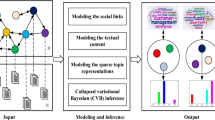Abstract
Topic detection and analysis is very important to understand academic document collections. By further modeling the influence among the topics, we can understand the evolution of research topics better. This problem has attracted much attention recently. Different from the existing works, this paper proposes a solution which discovers hidden topics as well as the relative change of their intensity as a first step and then uses them to construct a module network. Through this way, we can produce a generalization module among different topics. In order to eliminate the instability of topic intensity for analyzing topic changes, we adopt the piece-wise linear representation so that we can model the topic influence accurately. Some experiments on real data sets validate the effectiveness of our proposed method.
Preview
Unable to display preview. Download preview PDF.
Similar content being viewed by others
References
Mei, Q.Z., Zhai, C.X.: Discovering evolutionary theme patterns from text: an exploration of temporal text mining. In: KDD 2005. Proceeding of the eleventh ACM SIGKDD international conference on Knowledge discovery in data mining, pp. 198–207. ACM Press, New York (2005)
Zhou, D., Ji, X., Zha, H., Giles, C.L.: Topic evolution and social interactions: how authors effect research. In: CIKM 2006. Proceedings of the fifteenth ACM international conference on Information and knowledge management, pp. 248–257. ACM Press, New York (2006)
Wang, J.L., Xu, C.F., Li, G., Dai, Z.W., Luo, G.J.: Understanding research field evolving and trend with dynamic bayesian networks. In: PAKDD 2007. Proceedings of the eleventh Pacific-Asia Conference on Knowledge Discovery and Data Mining, pp. 320–331. Springer, Heidelberg (2007)
Segal, E., Pe’er, D., Regev, A., Koller, D., Friedman, N.: Learning module networks. Journal of Machine Learning Research 6, 557–588 (2005)
Landauer, T., Foltz, P., Laham, D.: Introduction to latent semantic analysis. Discourse Processes 25, 259–284 (1998)
Hofmann, T.: Probabilistic latent semantic indexing. In: SIGIR 1999. Proceedings of the twenty-second annual international ACM SIGIR conference on Research and development in information retrieval, pp. 50–57. ACM Press, New York (1999)
Blei, D.M., Ng, A.Y., Jordan, M.I.: Latent dirichlet aladdress. Journal of Machine Learning Research 3, 993–1022 (2003)
Wang, X.R., McCallum, A.: Topics over time: a non-markov continuous-time model of topical trends. In: KDD 2006. Proceedings of the twelfth ACM SIGKDD international conference on Knowledge discovery and data mining, pp. 424–433. ACM Press, New York (2006)
Blei, D.M., Lafferty, J.D.: Dynamic topic models. In: ICML 2006. Proceedings of the twenty-third international conference on Machine learning, pp. 113–120. ACM Press, New York (2006)
Pearl, J.: Probabilistic reasoning in intelligent systems: networks of plausible inference. Morgan Kaufmann Publishers Inc, San Francisco (1988)
Keogh, E.J., Pazzani, M.J.: An enhanced representation of time series which allows fast and accurate classification, clustering and relevance feedback. In: KDD 1998. Proceedings of the fourth ACM SIGKDD international conference on Knowledge discovery and data mining, pp. 239–243. AAAI Press, New York (1998)
Author information
Authors and Affiliations
Editor information
Rights and permissions
Copyright information
© 2007 Springer-Verlag Berlin Heidelberg
About this paper
Cite this paper
Wang, J., Xu, C., Shen, D., Luo, G., Geng, X. (2007). Understanding Topic Influence Based on Module Network. In: Goh, D.HL., Cao, T.H., Sølvberg, I.T., Rasmussen, E. (eds) Asian Digital Libraries. Looking Back 10 Years and Forging New Frontiers. ICADL 2007. Lecture Notes in Computer Science, vol 4822. Springer, Berlin, Heidelberg. https://doi.org/10.1007/978-3-540-77094-7_50
Download citation
DOI: https://doi.org/10.1007/978-3-540-77094-7_50
Publisher Name: Springer, Berlin, Heidelberg
Print ISBN: 978-3-540-77093-0
Online ISBN: 978-3-540-77094-7
eBook Packages: Computer ScienceComputer Science (R0)




